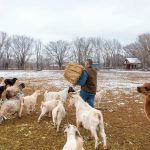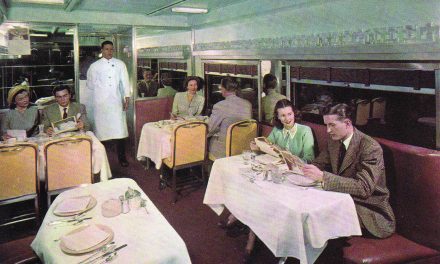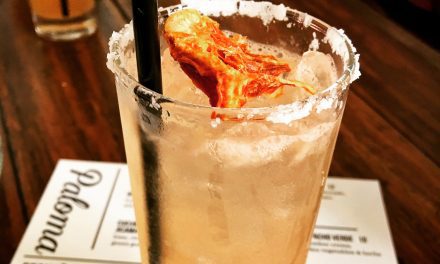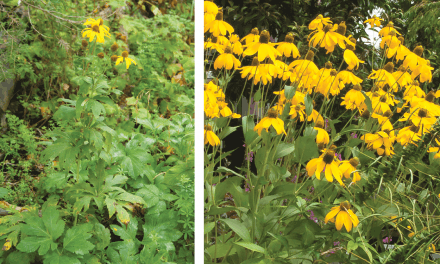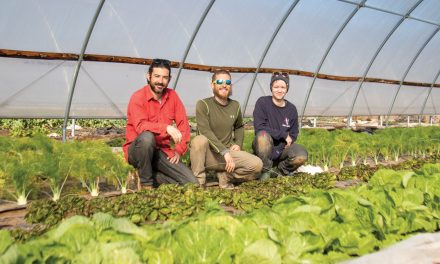
El Modelo Mexican Foods in Barelas, photo by Ungelbah Dávila.
South of downtown Albuquerque, east of the Rio Grande, west of the BNSF railroad tracks: this is Barelas. The colorful landmarks of Barelas are perhaps its most defining characteristic. Above vibrant new murals rise midcentury modern signs like the bubblegum-pink B Ruppe drugstore sign, the Red Ball Cafe sign, and the red, white, and blue Arrow Super Market sign that now points the way into an antique store. Along with iconic buildings that testify to Barelas’s early role as a thoroughfare, public artwork speaks to the resilience and nostalgia that animate this small but historically rich and culturally robust neighborhood.

Working Classroom, where La Mexicana (now at Third and Coal) operated in the 1980s, photo by Stephanie Cameron.
Barelas is older than Albuquerque’s Old Town, yet it has always remained a place where people live. Established by the colonial governor of Spanish New Mexico in 1662 (forty-four years before Albuquerque’s founding), the village was located at an important river crossing along El Camino Real de Tierra Adentro, the route fueling trade between communities from Mexico City to Ohkay Owingeh. Originally an agricultural community, Barelas grew and changed during the railroad boom starting in the 1880s. From 1922 to 1937, the neighborhood flourished along the original Route 66. The Red Ball Cafe building, the Streamline Moderne–style Durand Motor Company building, and the old service stations, like the one that’s now home to the nonprofit Casa Barelas, stand as relics of that bustling decade before Route 66 was redrawn to run along Central Avenue.
Today, Barelas is experiencing a renaissance, with spaces like the B Ruppe building becoming home to art galleries and event spaces and the rail yards being reinvented as a seasonal market (and occasional movie set). The drugstore, which moved in from Old Town in the 1960s, is now the Secret Gallery, with a micro museum in the back devoted to the history of the B Ruppe and the legacy of herbalist and curandera Maclovia Sanchez de Zamora. It is her elegant likeness that graces the outer north wall in a mural by Nanibah Chacon. Working Classroom, located in a space La Mexicana Tortilla Company leased in the 1980s, has led the way in helping diverse youth develop their artistic voices and has supported the installation of numerous murals that honor the neighborhood’s cultural wealth. The Rail Yards Market thrives in what was once the Santa Fe Railway Shops, a major employer in the neighborhood until AT&SF switched to diesel. Every Sunday from May to October, nearly two hundred vendors travel from as far as Velarde and as near as the South Valley to sell fruit, vegetables, flowers, paletas, tacos, macarons, salsas, and artwork in majestic buildings that speak to the neighborhood’s grit.

![220722_Northwest_View_with_tree_Logo-Top[1]](https://www.ediblenm.com/wp-content/uploads/2024/05/220722_Northwest_View_with_tree_Logo-Top1.jpg)
Left: Construction of a twenty-thousand-square-foot campus that will be the new headquarters of the Street Food Institute, photo by Ungelbah Dávila. Right: Architectural rendering of the new campus, by MASS Design Group.
Further carving out the neighborhood’s role in culture making, the Boiler Shop at the Rail Yards is slated to become the New Mexico Media Academy, a state-of-the-art film production training center. Another forward-looking development is the construction of a twenty-thousand-square-foot campus that will hold the new headquarters of the Street Food Institute (SFI). Founded as a nonprofit in 2014, SFI has operated out of Central New Mexico Community College (CNM) since 2017. Over the past decade, their program has incubated businesses from the now-established Vegos—a from-scratch, vegan, New Mexican–inspired food truck turned brick and mortar—to the up-and-coming Sentli. Elizabeth Bibiano, co-owner of Vegos, credits SFI’s business incubator program with propelling her and husband Jonathan Bibiano’s business forward and nurturing their growth. In addition to partnering with CNM’s Culinary Arts Program, SFI offers their own training program to any community member interested in learning the ins and outs of creating a food business. The fifteen-week program covers everything from creating a business plan to pricing a menu to permitting. Through an internship program, budding food entrepreneurs gain on-the-job-training by apprenticing in SFI’s catering service, at one of their food trucks, or at their café, which will be moving from CNM to the new Barelas campus later this year. The program is available for $250.
“It is really, really important to us to eliminate as many barriers as we can for people,” says Tina Garcia-Shams, SFI’s executive director. “We’ve taught the class bilingually, and we’re working on an all-Spanish class right now. We try to make it as accessible financially as possible, and even when people can’t afford that, we find a way to get a scholarship.”
SFI was also given an Economic Development Administration grant that will help them develop an online curriculum that is available to anyone in the country. They’ve held four-day boot camps in Farmington and Silver City and plan to continue outreach across the state.
“I think food is the great connector,” says Garcia-Shams. “Not just eating it but making it. I mean, your heart goes into that, and people know when you’re cooking from your heart and sharing a part of yourself with your community. I think food can equalize for people, you know. And so I think that’s why I love the work so much. I love seeing how everybody has a different way that they do that, and the different types of cuisine that they’re passionate about and want to share.”
Through fundraising and financing from a congressional funding award, as well as financing from project partner Homewise, a nonprofit community development finance institution, the approximately $10 million project is slated to be completed this summer. In addition to two new buildings, the development encompasses an historic Barelas building that originally housed Coronado Chili Products and has since been home to numerous notable gallery and DIY spaces, including Small Engine Gallery, La Chancla, and Fourteenfifteen Gallery, which will continue putting on shows and events in the renovated space. Additionally, the new campus will offer a community plaza with gardening beds, trees, tables, and a pizza oven. East of the gathering space, the smaller of the new buildings will house a handful of street-facing storefront spaces slated to host a sweet shop and other culinary businesses. One of those will be designated for SFI program graduates to use as an incubator space for their businesses.
“As our graduate students are ready to launch, they can use this space as either a pop-up, or they can operate their business out of there for three to six months just to kind of get themselves going and get feedback on their concept,” says Garcia-Shams.
On the first floor of the two-story main building, designed by award-winning MASS Design Group, a demo kitchen and education space will run along large north- and east-facing windows. “We’ll do all of our cooking and entrepreneurial classes out of here, and any other programming that we do,” says Garcia-Shams as we tour the space. “We also really hope that it becomes a space for other organizations to do team building or other activities,” she adds, “because we want it to be a really active space. It’s really important for us to feel part of the neighborhood and for them to feel part of what we’re doing here.”
On the south end of the first floor will be the shared kitchen, available to SFI students as well as to rent by any food entrepreneur. It will have prep areas, refrigeration, fryers, stoves, and all the other bells and whistles found in a top-of-the-line commercial kitchen. This area will also include two specialty kitchens, one specific to bakers and their unique equipment needs. Rental prices, says Garcia-Shams, will be based on a tiered system.
“One of the things we know is that as students are just launching their business, it’s really hard, right? So we want to make that as financially easy for them as possible,” she says. “So our goal is to create a system where for the first three months, rental fees are at a reduced rate so that it’s one thing less that they have to think about, and as they grow and build their business, then they can move into a different tier.”
It seems fitting that the SFI campus, located on Fourth Street between Bell Avenue and Simpier Lane, will be neighbors to two of the city’s oldest and most beloved eateries, Barelas Coffee House and El Modelo Mexican Foods.



Left: Febronio Guerrero in the kitchen at El Modelo Mexican Foods. Top right: Tamales at El Modelo. Bottom right: El Modelo kitchen. Photos by Ungelbah Dávila.
On the southeast side of Barelas, once known as Tortilla Flats, El Modelo’s vibrant signage and steady flow of customers stand out in an otherwise industrial area. According to the Barelas Historic Walking Tour, the building was one of three to survive an urban renewal project in the early 1970s, when more than two hundred homes were demolished. El Modelo opened in 1929 in a three-bedroom house at 1715 Second Street, selling tortillas and tamales out of a one-room “factory” until the family moved out and, on the same site, built the facility where curious customers can watch tamale production while waiting to place their orders. They are known for their meaty tamales but offer any and all New Mexican foods, from rolled enchiladas to stuffed sopapillas to chile relleno burritos. The take-out only venue also offers carnitas, chicharrones, refried beans, and more by the pound, with masa dough and red chile pods for those wanting a little help with a homemade meal. Those wishing to eat immediately can dig in at one of the outdoor picnic tables.

Left: Geri Lucero and Mike Gonzales, owners of Barelas Coffee House. Top right: Huevos rancheros with red chile. Bottom right: Behind the counter at Barelas Coffee House. Photos by Ungelbah Dávila.


Barelas Coffee House, directly across the street from SFI’s new campus at 1502 Fourth Street, only rests on Sunday. On other days, this legendary local treasure is one of the most popular places in town for breakfast and lunch. It often has long lines of eager patrons, sometimes including celebrities and US presidents (Barack Obama has stopped in), other times including local movers and shakers. The sit-down restaurant with diner vibes was started in 1978 by Mike Gonzales, and, like El Modelo, Barelas Coffee House has an extensive menu of authentic New Mexican comfort food—think carne adovada and eggs or a bowl of green chile and beans—as well as a fabulous burger and sandwich selection. A nod to their name, their signature horchata cappuccino is the perfect way to begin a meal that according to many, many Google reviewers, tastes just like Grandma made it.

Juanita’s Comida Mexicana (original Tasty Freeze Drive-In), photo by Stephanie Cameron.
Approaching the neighborhood’s north end, the old Tasty Freeze Drive-In, built in 1957, now houses Juanita’s Comida Mexicana. Juanita’s runs from Mexican to New Mexican, with tampiqueña on Mondays, chile colorado and barbacoa, flautas and gorditas served alongside huevos rancheros with red or green. In operation for some twenty-seven years, Juanita’s is one of the neighborhood’s younger food businesses, but you wouldn’t know it from the regulars who sit down as if in the family living room and order lunch without looking at the menu.
Not least, at the neighborhood’s northernmost border, La Mexicana Tortilla Co. continues producing masa, made in house from non-GMO New Mexico–grown corn, along with tortillas, chips, and posole, for distribution at an impressive number of in-state restaurants. Their tortillas, chips, and tamales are also sold at their own storefront at Third and Coal. The small restaurant, set far enough back from the road to be easily missed, serves New Mexican classics for breakfast and lunch five days a week.
The neighborhood’s constraints are also its gifts: The Rio Grande, forming the neighborhood’s western boundary, makes it a gateway to the bosque. The railroad tracks that run along its eastern side have been cited as a cause for some of the economic struggles resulting from geographic isolation, but now the revitalization of the rail yards is bringing fresh growth and tapping into Barelas pride. And this year, following years of work by the Barelas Community Coalition, a fresh infusion of state funds will go toward making the neighborhood more pedestrian friendly and, thanks to planters and lots of new trees, more green.

Ungelbah Dávila
Ungelbah Dávila lives in Valencia County with her daughter, animals, and flowers. She is a writer, photographer, and digital Indigenous storyteller.

